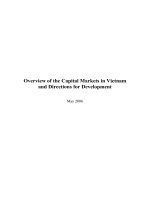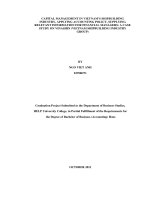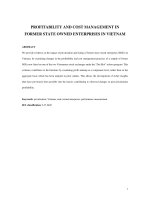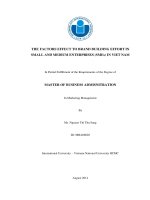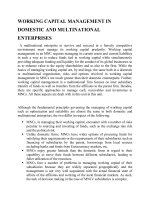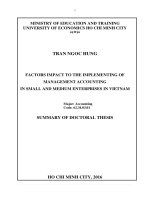WORKING CAPITAL MANAGEMENT IN DOMESTIC AND MULTINATIONAL ENTERPRISES
Bạn đang xem bản rút gọn của tài liệu. Xem và tải ngay bản đầy đủ của tài liệu tại đây (124.62 KB, 19 trang )
WORKING CAPITAL MANAGEMENT IN
DOMESTIC AND MULTINATIONAL
ENTERPRISES
A multinational enterprise to survive and succeed in a fiercely competitive
environment must manage its working capital prudently. Working capital
management in an MNC requires managing its current assets and current liabilities
in such a way as to reduce funds tied in working capital while simultaneously
providing adequate funding and liquidity for the conduct of its global businesses so
as to enhance value to the equity shareholders and so also to the firm. While the
basics of managing working capital are, by and large, the same both in a domestic
or multinational organization, risks and options involved in working capital
management in MNCs are much greater than their domestic counterparts. Further,
working capital management in a multinational firm focuses on inter subsidiary
transfer of funds as well as transfers from the affiliates to the parent firm. Besides,
there are specific approaches to manage cash, receivables and inventories in
MNCs. All these aspects are dealt with in this unit in this unit.
Although the fundamental principles governing the managing of working capital
such as optimization and suitability are almost the same in both domestic and
multinational enterprises, the two differ in respect of the following:
•
•
•
•
MNCs, in managing their working capital, encounter with a number of risks
peculiar to sourcing and investing of funds, such as the exchange rate risk
and the political risk.
Unlike domestic firms, MNCs have wider options of procuring funds for
satisfying their requirements or the requirements of their subsidiaries such as
financing of subsidiaries by the parent, borrowings from local sources
including banks and funds from Eurocurrency markets, etc.
MNCs enjoy greater latitude than the domestic firms in regard to their
capability to move their funds between different subsidiaries, leading to
fuller utilization of the resources.
MNCs face a number of problems in managing working capital of their
subsidiaries because they are widely separated geographically and the
management is not very well acquainted with the actual financial state of
affairs of the affiliates and working of the local financial markets. As such,
the task of decision making in the case of MNCs' subsidiaries is complex.
•
Finance managers of MNCs face problems in taking financing decision
because of different taxation systems and tax rates.
In sum, though MNCs have some advantages in terms of latitude and options in
financing, the problems of working capital management in MNCs are more
complicated than those in domestic firms mainly because of additional risks in the
form of the currency exposure and political risks as also due to differential tax
codes and taxation rates.
INTRA CORPORATE TRANSFER OF FUNDS
Intra corporate transfer of funds comprises transfer of funds from affiliates/
subsidiaries to the parent company and also transfer of funds as among affiliates.
Such transfers may be in the form of royalties, fees, payment for acquisition of
inputs and equipments, interest on loans, repayment of loans, dividends and
repatriation of the original investments.
Royalty is paid to the owner in return for the use of patents, technology or a trade
name. It represents a payment usually by an affiliate to the parent for getting the
right to use the company's name or special processes, usually under a licensing
arrangement. Royalties are usually stated as percentage of sales revenue so that the
owner is compensated in proportion to the volume of sales.
Fees are paid in lieu of professional services and expertise, usually provided by the
parent to the affiliates. License fees are usually based on a percentage of the value
of the product or on the volume of production. Host countries are generally found
to object to the payment of fees for the services of visiting executives or
maintenance personnel on the ground of higher scale of compensation. This
problem is generally noticeable in the case of US MNCs who charge significantly
higher compensation for their services as compared to other countries. This
problem can be minimized if scale of fees is specifically stated in a formal
agreement between the parent and the affiliate at the outset.
Transfer of funds by way of dividend payments from the affiliates to the parent
company is dependent upon host country's policy of dividend payment, and
dividend transfer policy of the affiliates.
Remittance of dividends is a classical method by which firms transfer profits back
to owners-individual shareholders and parent firms. Policy regarding dividend
payment is basically influenced by tax factor, political risk, foreign exchange risk,
liquidity factor and joint venture consideration.
Dividend transfer policy of an affiliate is impacted by tax laws of host country.
Most countries levy tax on retained earnings and distributed earnings at different
rates. Parent countries generally levy a tax on foreign dividends received but allow
tax credit for foreign taxes already paid on that income.
In case of political uncertainty, parent firm may require affiliates to remit the entire
locally generated funds not needed to finance their expansion programmes.
Pursuance of stable dividend payout policy by the affiliate may be a good idea.
This will avoid the possibility of the company being perceived as using dividend
payment for transferring funds to parent company.
MNCs may decide to speed up the transfer of funds through dividend if exchange
rate risk is perceived: This perception is usually part of a larger strategy of
funnelling funds from weak currency to strong currencies. However, decisions to
accelerate dividend payments ahead of the event should take into consideration
interest rate differences and the likely impact on host country relations. Speeding
up or slowing down payments is termed as "Lead and Lags".
Liquidity position of the affiliate also influences the dividend transfer policy of the
parent. A fast expanding affiliate may not have adequate cash to remit a dividend
equal to its earnings because profits of such firms are often tied up in everincreasing receivables and inventories.
Conversely, affiliates having large amount of cash collected from past receivables
may decide to pay higher dividend so as to transfer funds to the parent.
Conflicts of interest of joint venture partners may also affect dividend transfer
policy of an MNC parent. An MNC desirous to position funds internationally may
not be liked by independent partners or local shareholders because the latter
perceive their benefits from the success of the particular Joint Venture rather than
from the global success of the MNC. They may object to reduction of dividends on
the fall of earnings or rise in dividend on the surge of earnings and prefer to go for
stable dividend policy: This is why many MNCs prefer 100% ownership of
affiliates so as to avoid possible conflicts of interests with outside shareholders.
Intra-corporate transfer of funds has a number of constraints with which a finance.
manager of an MNC must be familiar. The greatest problem in this respect is
political in nature which may range from limits to transfer of certain types of funds
to outright blockage of funds and inconvertibility of currency. Sometimes due to
foreign exchange problems being faced by host country, foreign exchange controls
are clamped resulting in barrier to transfer of funds. This also creates problem of
servicing of loans. However, by taking loans from an international banking
institution, the problem of loan service can be eased because the host country may
not take penal action against such an arrangement for fear of damage to their
international credit standing.
Problem generally arises in most of the developing countries in respect of
remittance of dividends by the affiliates to their parent. This is for the fact that
these host countries prefer retention of larger proportion of the affiliates' earnings
and their investment within the country. Magnitude of the problem can, however,
be reduced if dividend transfer policy is spelt out at the outset and communicated
to the host country's authorities.
TRANSFER PRICING
Transfer prices are the prices set on Kea company exchange of goods and sales.
The pricing of goods and services traded internally is one of the most critical issues
and assumes still greater importance in respect of intra corporate exchange of
goods and services as among affiliates and the parent firm because it provides an
effective weapon in the hands of an MNC to maximize its value.
The most important uses of transfer pricing are:
•
•
•
•
•
•
To minimize the total tax liability;
To reduce tariffs and avoid quantitative and administrative restrictions on
imports;
To position funds in locations that will suit the management's working
capital policies;
To avoid exchange control;
To maximize transfer of funds from affiliates to the firm;
To window-dress operations so as to improve financial health of an affiliate
and establish its high credibility in the financial markets.
Transfer pricing is a very difficult decision to make. Even purely domestic
firms do not find it easy to reach agreements on the best method for setting
prices on transactions between related tots. In case of an MNC, the decision
is further compounded by exchange restrictions on the part of the host
country where the receiving affiliate is located, a differential taxation system
and different tax rates between the two countries, and import duties and
quotas imposed by the host country. Most countries have transfer pricing
guidelines similar to those in the U.S.A.
An MNC finance manager has to strike satisfactory trade off between
conflicting considerations of fund positioning and income tax. A parent
company in its effort to funnel funds out of a particular country will charge
higher prices on goods sold to its affiliate to the extent the host country
government permits. In contrast, if a foreign affiliate is to be financed, the
reverse technique of charging lower prices can be used. A higher transfer
price facilitates accumulation of funds in the parent's country. Transfer
pricing also permits transfer of funds as among sister affiliates. Multiple
sourcing of component parts on a global basis allows switching between
suppliers within the corporate family as a device to transfer funds.
Income tax consideration is an important factor which an MNC has to
reckon with while setting a transfer price. It is through transfer pricing
mechanism that an MNC finance manager can maximize their worldwide
corporate profits by setting transfer prices to minimize taxable income in a
country with a high tax rate and maximize income in a country with a low
income tax rate. A parent desiring to reduce the taxable profits of a
subsidiary in a high tax country will set transfer price at a higher rate to
increase the costs of the subsidiary, thereby reducing taxable income.
Methods of Determining Transfer Prices
The Organization for Economic Cooperation and Development (OECD)
Committee has recommended three methods: (a) Comparable Uncontrolled
Price Method, (b) Resale Price Method, and (c) Cost-Pitts Method for use by
member countries. U.S. Internal Revenue code in its attempt to circumscribe
freedom to set transfer prices has also provided for setting transfer price by
these methods.
(a)Comparable Uncontrolled Price Method:- This method of setting transfer
price is based on market forces and hence considered as the best evidence of
aim's length pricing. However, there are practical problems involved in
using this
method because of differences in quality, quantity, timing of sales and
proprietary trade marks
(b) Resale Price Method. In the resale price method, considered as a secondbest approach to arm's length pricing, first of all final selling price to an
independent buyer is set and then an appropriate markup for the distribution
subsidiary is subtracted. This markup represents the subsidiary's costs and
profits. The price so set is then employed as the intra-company transfer price
for similar items. However, it is not easy to determine an appropriate
markup, particularly when the distribution affiliate adds value to the item
through subsequent processing or packaging or both.
(c) Cost-Plus Method: The transfer price under cost-plus method is
determined by adding suitable profit markup to the seller's full cost
comprising direct cost and overhead cost. Allocation of overhead cost in
computing full cost poses problem and involves subjectivity, especially
when joint products are involved. As such, this method provides enough
scope for negotiation.
Re- Invoicing Centers
A re-invoicing center is a separate corporate subsidiary that acts like a
middle man between the parent and related unit in one location and all
foreign subsidiaries in a geographic region. The re-invoicing center takes
title to all goods sold by one corporate unit to another affiliate or to a thirdparty customer, but the physical movement of goods is direct from the
manufacturing plant to the purchaser. The center pays the seller and, in turn,
is paid by the purchasing unit.
The principal objective of these re-invoicing centers is to funnel the profits
arising from these transactions to lower tax affiliates and away from the
higher-taxed parent or affiliate. The U.S. tax system is a larger part of the
reason that U.S. MNCs tend to conduct their currency risk management
offshore. These centers also often manage the MNC's currency risk
exposures. Re-invoicing center personnel can develop a specialized expertise
in choosing which hedging technique is best at any moment, and they are
likely to obtain more competitive foreign exchange quotations from banks
because they are dealing in larger transactions. By guaranteeing the
exchange rate for future order, the re-invoicing center can set firm local
currency cost in advance, enabling the distribution subsidiaries to make firm
bids to unrelated final customers, and to protect against the exposure created
by a backlog of unfilled orders. Finally, the re-invoicing center can manage
intra-subsidiary cash flows, including leads and lags of payments. With a reinvoicing center, all subsidiaries settle intra-company accounts in their local
currencies. The center needs only hedge residual foreign exchange rate
changes.
However, setting and operating re-invoicing center involves cost. As such,
benefit-cost analysis should be made while deciding about establishment of
a re-invoicing center.
MANAGEMENT OF BLOCKED FUNDS
At times, an MNC faces problem of repatriation restriction by host country
government which places embargo on transfer of the earnings of the
overseas subsidiary. Thus, funds which are not allowed to be repatriated
permanently or temporarily are called "blocked funds". These funds
represent cash flows generated by a foreign project that cannot be repatriated
to the parent firm because of capital flow restrictions by the host
government.
There are various reasons for the host government for blocking the
repatriable funds. One such reason is the grim foreign exchange crisis
engulfing the host country. In such cases, the government may block
repatriable Ends of overseas subsidiaries and limits foreign exchange to
financing essential imports on other payments. Sometimes political factor is
responsible for the blocking of funds repatriable by the foreign entities.
Frequently, this occurs with change in national government which, out of
political animosity, overturns the previous government's policies and places
restrictions on the movement of the funds of the overseas units. A firm may
also face the ire of blockage of repatriable profits earned by its offshore
subsidiary if it has been found flouting local laws and regulations and/or
operating to the detriment of local interests.
Blocking of funds can take several forms ranging from non-convertibility of
the host currency to prior permission for repatriation of earnings. In between
the two, blockage of funds may involve repatriation of only a portion of the
funds, repatriation only after a certain time lag, a combination of restrictions
on the proportion of funds to be repatriated and the time constraints and
absolute ceilings on the total of funds that can be repatriated over a certain
period of time.
Prudent management of financial resources of multinational firms calls for
effective utilization of funds blocked across the home turf A parent firm can
make use of certain strategic arrangements for using these funds properly.
For example, the subsidiary may he directed by the MNC to set up a
research and development division which incurs costs and possibly generates
revenues for other subsidiaries.
The parent firm may pursue strategy of transfer pricing in a manner that will
increase the expenses incurred by the affiliate. A host country government is
likely to be more lenient on money being used to meet local expenses than
on earnings remitted to the parent.
Another strategic move could be the directive to the affiliate by the parent to
borrow from a local bank rather than from the former and repay the interest
and the principal out of as local earnings.
Charging fees and royalties at higher rate, leads and lags in making
payments abroad and payment of dividends at higher rate to local
stockholders, can be the other direct measure which an MNC can take to
repatriate blocked funds. The MNC can also instruct its affiliate to reinvest
the blocked funds in the host country in a manner that avoids deterioration in
their real value because of inflation or exchange depreciation.
Tactics for transferring funds indirectly include:
• Parallel or back-to back loans
• Purchase of commodities for transfer abroad `
• Purchase of capital goods for corporate wide use
• Purchase of local services for worldwide use
• Hosting corporate conventions, vacations and so on
Two more methods which have been gaining popularity in recent years are
increasing the value of the local investment base because the level of profit
remittance often depends on the amount of a company's capital. One way to
enhance an affiliate's capital is to buy used equipment at artificially inflated
value. The other way is for an affiliate to acquire a bankrupt firm at a large
discount from book value. The acquisition is then merged with the affiliate
on the basis of the failed firm's original book value, thereby raising the
affiliate's equity base.
MULTINATIONAL CASH MANAGEMENT
The basic principle to guide the management of cash balance holdings in
international working capital management is, broadly, similar to the one
applicable to domesticsituation. That is, after carefully covering all the
contingencies under contemplation, besides, regular requirements, the ideal
cash balance holding should be zero (0). However, such an ideal situation
rarely exists even in case of domestic enterprise; in spite of massive
application of computers and operations research techniques. This is as a
result of problems in human perception which continue to hunt modern
managers in their role as financial planners. That is, even the most perfect
system of planning has some lacuna to warrant the retention of residual cash
reserve.
Problem of Managing Cash in MNCs
Cash Management in an MNC is primarily aimed at minimizing the overall
cash requirements of the firm as a whole without adversely affecting the
smooth functioning of the company and each affiliate, minimizing the
currency exposure risk, minimizing political risk, minimizing the transaction
costs and taking full advantage of the economies of scale and also to avail of
the benefit of superior knowledge of market forces. However, these
objectives are in conflict with each other leading to increased complexity of
the cash management. For instance, minimization of the political risk
involves conversion of all receipts in foreign currencies in the currency of
the home country. This may, however, go against the interest of the affiliates
who need minimum working capital to be kept in the local currencies to
meet their operational requirements. Further, minimization of transaction
costs involved in currency conversions calls for holding cash balances in the
currency in which they are received. In another respect too, primary
objectives are antagonistic to each other. A subsidiary, for example, may
need to carry minimum cash balances in anticipation of future payments due
to the time required to channelize funds to such a country. Holding of such
balances in excess of immediate requirements may ostensibly impringe on
the objective to benefit from economies of scale in earning the highest
possible rate of return from investing these resources.
Another major problem which an MNC faces in managing cash is with
respect to estimation of cash flows emanating out of operations of its
affiliates. This problem arises because of foreign exchange fluctuations.
Similar problem arises in estimating cash inflows stemming out of future
sales because actual volume of sales to overseas buyers depends on foreign
exchange fluctuations. The sales volume of exports is also susceptible to
business cycles of the importing countries.
Uncertainty arises with regard to cash collections from receivables because
it is the quality of credit standards that will decide the value of goods sold to
be received back in cash. Loose credit standards may cause a slow. down in
cash inflows from sales which could offset the benefits of augmented sales.
In view of the above problems leading to increased uncertainty in estimating
cash flows, the management may be constrained to carry larger amount of
cash balances so as to protect the firm against any crisis.
Cash management in an MNC is further complicated by the absence of
effective tools to expedite transfers and by the great variations in the
practices of financial institutions.
As such, an international finance manager must exercise great prudence in
forecasting cash flows of the affiliates.
Cash Flow Analysis: Subsidiary Perspective
Prudent working capital management of an MNC is dependent, inter alia,
upon liquidity management of its affiliates. This, therefore, calls for
estimating cash outflows and inflows periodically to ascertain excess or
deficient cash for a period of time.
As noted earlier, cash outflow by the subsidiary occurs when the latter buys
raw materials. Cash is also needed to meet the costs incurred in
manufacturing goods. Cash inflow to the subsidiary takes place when sales
proceeds are received in cash and receivables for the goods sold on credit are
collected after sometime.
Cash outflow by subsidiary also comprises dividend payments and other fees
to be made periodically to the parent. The level of dividends paid by
subsidiaries to the parent is dependent on liquidity needs, potential uses of
funds at various subsidiary locations, expected movements in the currencies
of subsidiaries, and host-country government regulations.
Once estimates of cash outflows and inflows are made, the subsidiary will be
in a position to know there is cash surplus or deficit for a particular period. If
cash deficiency is expected, short-term financing is necessary. In case of
excess cash, it must decide how the surplus cash will be used. A firm, it
must be noted, may maintain liquidity without substantial cash balances.
Centralized Cash Management
So as to maintain adequate liquidity without jeopardizing profitability, an
MNC and its subsidiaries carry minimum amount of cash balances to meet
transactional and precautionary demands. While each subsidiary manages its
working capital and reaches its own decision as to the appropriate level. In
most of the cases the affiliates are better equipped to make a decision as to
what constitutes adequate balance in view of their intimate knowledge of
their circumstances. However, there is a strong need to monitor and manage
the cash flows between the parent and the subsidiaries and also between the
individual subsidiaries. This task of international cash management should,
therefore, be delegated to a centralized cash management group.
Centralization, in this context, does not necessarily entail the pooling of
overall liquid resources, although some degree of pooling would take place,
but rather the centralization of reports, information and most importantly,
the decision-making process as to cash mobilization, movement and
investment outlets.
An effectively designed and managed centralized system has the major
advantage of holding of overall cash balances to the minimum, enabling the
MNC to make fuller utilization of the idle cash and maximize earnings
without risking liquidity throughout the system. Besides, the centralized
system permits the centre to make full utilization of a multilateral netting
system, both inter-affiliate and between the MNC and other corporations so
as to minimize transaction costs and currency exposure and enables the
centre to employ optimally the various hedging strategies available to the
firm so as to ensure enforcement of the MNC's foreign exchange exposure
policies. Above all, with centralized system of cash management, an MNC
can take maximum advantage of the transfer pricing mechanism within the
legal and administrative mechanism and thereby improve the profitability of
the corporation.
It may not be always possible for the centralized cash management division
of an MNC to accurately forecast events that affect parent subsidiary or inter
subsidiary cash flows. It should, however, be adequately equipped to
respond quickly to any event by considering any potential adverse impact on
cash flows and take measures to avoid such an adverse impact. It should
have sources of funds (credit lines) available to meet the cash needs and it
must have suitable strategies to deploy the excess funds in the system.
Techniques to optimize Cash Flows
Cash flows can be optimized through:
•
•
Accelerating cash inflows
Managing inter-subsidiary cash transfers
Accelerating Cash Inflows
Cash inflows can be prompted through quick deposit of customer's cheques,
establishing collection centers, lock-box method and other devices.
Minimizing currency conversion costs
Cash flow can also be optimized through Netting. Netting involves
offsetting receivables against payables of the various entities so that only the
net amounts are eventually transferred among affiliates. An MNC can also
utilize multilateral netting with outside firms and agencies.
This technique optimizes cash flow by reducing the administrative and
transaction costs arising out of currency conversion. It also reduces
unnecessary float, funds that are in the process of being transferred among
affiliates instead of being invested by the centre. The process of netting
forces tight control over information on transaction between subsidiaries
leading to greater coordination among all subsidiaries to accurately report
and settle their various accounts. Netting also makes cash flows forecasting
easier since only net cash transfers are made at the end of each period, rather
than individual cash transfers throughout the period.
There are two kinds of netting.
• A bilateral netting system involves transactions between two units:
between the parent and a subsidiary or between two subsidiaries.
•
A multilateral netting system usually involves a more complex
interchange among the parent and several subsidiaries. Multilateral
netting system is most useful to MNCs in reducing administrative and
currency conversion costs. Such a system is highly centralized so that
all necessary information is consolidated. With the help of the
consolidated cash flow information net cash positions for each pair of
units (subsidiaries or parent) can be determined and the actual
reconciliation at the end of each period can be done.
Managing Inter-subsidiary Cash Transfers
Through techniques of leading and lagging, cash flows can be managed to
the advantage of a subsidiary, If A purchases supplies from B and pays for
its supplies earlier than necessary. This technique is called leading.
Alternatively, if B sells supplies to A, it could provide financing by allowing
A to lag its payments. The leading or lagging strategy can help in improving
efficiency of cash utilization and thereby reducing debt. Some host
governments prohibit this practice by requiring that a payment between
subsidiaries occurs at the time at which goods are transferred. MNC
management must, therefore, be aware of existence of such prohibitory laws.
Complications in optimization of Cash Flow
The process of optimalization of cash flows in an MNC is complicated
because of unique features of the company, government restrictions and
characteristics of banking system.
Optimisation of cash flow can be impeded because of the specific situations
existing among subsidiaries of an MNC.
For example, if one of the subsidiaries delays payments to other subsidiaries,
the latter may have no option but to borrow until the payments are received.
This problem can be overcome by the centralized approach that monitors all
inter-subsidiary payments.
Cash flow optimisation policy is also disrupted by government restrictions.
For example, some governments ban the use of a netting system. In addition,
some governments prohibit transfer of cash from the country, thereby,
preventing net payments from being made.
Problem in efficient utilization of cash also arises due to insufficient banking
services in a country. Banks in the USA, for example, are advanced in cash
transfers but other countries' banks do not offer such services to MNCs.
More often than not, MNCs want some form of zero-balance account system
which allows the customer to use excess cash funds to make payments but
earn interest until they are used. This kind of facility is not available in most
countries. Some countries may lack in lock box facility. In many developing
countries MNCs do not even get updated detailed position of their account.
As a result, the management may find it too difficult to utilize the cash
resources efficiently.
Investing Excess Cash
Investing surplus cash in liquid assets such as Euro currency deposits, foreign
treasury bills and commercial paper, etc is one of the key functions of international
finance manager. While making decision in this regard, many crucial issues merit
thorough consideration. Some of these issues are:
•
•
•
•
Should the excess cash of all subsidiaries be pooled together or remain
separated?
How can the effective yield expected from each possible alternative be
determined?
What does interest rate parity suggest about short-term financing?
Will it be useful to diversify investment among currencies?
Separate or Centralized approach:
While handling the issue regarding deployment of surplus cash, an MNC has to
decide if individual subsidiaries will make separate investments on their own or a
centralized approach will be followed to pool the excess cash from each subsidiary
which will then be converted into a single currency for investment purposes.
However, the advantage of pooling may be offset by the transaction costs involved
in conversion in a single currency. Even then aiso centralized cash management
could be useful. Alternatively, the short-term cash available in each currency could
be pooled together so that there would be a separate pool for each currency. The
excess cash of subsidiaries in a particular can still be used to satisfy other
subsidiary having deficiency in that currency. This strategy will save transaction
costs of the MNC.
If an MNC is left with excess cash and expects future cash outflows in foreign
currencies which are to gain in value it may decide to cover such positions by
making short-term deposits in those currencies, dovetailing the maturity of a
deposit to the date of payment.
The remaining cash, if any, may be invested in domestic or foreign short-term
securities keeping in view potential yield of the securities and possible exchange
rate movements.
Determining the Effective Yield:
For an international finance manager it is effective yield, not the interest rate,
which is important because the effective yield, say of a bank deposit, considers
both the interest rate and the rate of appreciation (or depreciation) of the currency
denominating the deposit and can, therefore, be very different from the quoted
interest rate on a deposit denominated in a foreign currency.
The effective yield on the foreign deposit can be determined by using the
following formula:
r= (1+if) (1+ef)-1
where,
r represents the effective yield on the foreign deposit;
i f represents the quoted interest rate on foreign currency;
e f is the percentage change (appreciation or depreciation) in the value of the
currency representing the foreign deposit from the date of deposit to the date
of withdrawal.
Suppose that an MNC X of the US has surplus cash of $2,000,000. It can
invest it in a one-year domestic bank deposit @ 6 percent. The company
finds that one-year deposit in Australian bank would fetch 9 percent. The
exchange rate of the Australian dollar at the time of investment is $0.68. Due
to higher interest rate X decided to invest in Australia. The U.S. dollars are,
therefore, converted to Aus $2,941,176 and then deposited in a bank. After
one year, X receives Aus $3,205,882 (equivalent to initial deposit plus
9percent interest on the deposit). X then converts it into U.S. dollars.
Assume that the exchange rate at this time is $72 (an appreciation 5.88%).
The funds will convert to $2,308,236. Thus, the yield on this investment to
X is:
r = (1 + .09) [1 + (.0588)] -1
=1541, or 15.41 %
Now assume that the Australian dollar depreciates from $.68 to $.65 or by
4.41 %, the effective yield will be:
r = (1 + .09) [1 +(-.0441)] -1
=.0419, or 4.19%
The effective yield could be negative if the currency denominating the
deposit depreciates to an extent that more than offsets the higher interest
accrued from the deposit.
Implications of Interest Rate Parity:
Generally, it is believed that a foreign currency with a high interest rate
would be an ideal short-term investment outlet for covered interest arbitrage.
However, such a currency will normally exhibit a forward discount that
reflects the differential between its interest rate and the investor's home
interest rate. This relationship is based on the theory of interest rate parity.
Investors will not lock in higher return when attempting covered interest
arbitrage if interest rate parity exists.
Short-term investment may be feasible if interest rate parity exists but this
has to be on an uncovered basis (without use of the forward market). In
other words, short-term foreign investing may be more profitable than
domestic investing but it cannot be guaranteed.
Diversifying Cash across Currencies:
In order to avoid the possibility of incurring substantial losses arising out of
depreciation of a foreign currency, an MNC prefers to diversify its investible
funds among various foreign currencies. To what extent a portfolio of
investments denominated in various currencies will reduce risk would depend
on the currency correlations. Ideally, the currencies represented within the
portfolio will show low or negative correlations with each other. When
currencies are likely to be affected by the same underlying event, their
movements tend to be highly correlated, and diversification among these types
of currencies does not substantially minimize exchange rate risk. of currencies
does not substantially minimize exchange rate risk.
MULTINATIONAL RECEIVABLES
MANAGEMENT
Basic considerations influencing credit and collection policies of MNCs are the
same as those of domestic firms. However, certain additional variables such as
currency fluctuations, exchange restrictions, differential inflation rates, etc have
also to be reckoned with by an MNC while managing receivables.
In an MNC, receivables arise for a short period when goods are sold on cash
against documents or sight draft and are in transit or for the time which lapses
between the drawing of the draft and its payment by the importing firm or
banker.
Receivables mainly arise when goods are shipped on open account,
consignment shipments and shipments of goods and services between parent
and affiliates, as well as among the latter. Besides, local sales on credit by
subsidiary units gives rise to receivables for the selling units, as well as for the
MNC as a whole.
While deciding about sales on credit to a particular firm, an MNC has to
compare incremental benefits with incremental costs, as in the case of a
domestic firm. In addition, an additional factor, viz., foreign exchange loss on
sales on credit made by one of its subsidiaries has to be reckoned with.
Another issue related to receivables management in an international firm relates
to factoring of receivables. Decision on factoring should take into account its
benefits and costs. For example, factoring permits the exporter to quote more
competitive terms or to ship goods on open account rather than insisting on cash
terms or shipment against letter of credit. It relieves the exporting firm from the
costs of credit investigation, assessing the political risk and collection. The
factoring agency is better equipped to assess these risks and can manage credit
analysis and collection more efficiently and at lower costs.
In view of the above, it is advisable to small firms who cannot afford the cost of
credit investigation and risk evaluation to factor their receivables. Firms having
occasional export sales to a few geographically dispersed countries can also hire
the services of factoring agency.
However, international factoring is still an expensive process. Factoring fees
differ depending on the size, quality, and the annual turnover of the underlying
receivables.
MULTINATIONAL INVENTORY
MANAGEMENT
Fundamental decision rules determining the optimal level of stock of raw
materials and components, work-in-process and finished goods are the same for
both MNCs and domestic firms. Even the techniques employed to determine the
level of required, safety stocks are also the same in both the cases. However,
MNCs have to face certain additional problems in managing inventories which
a domestic firm does not experience. These problems are the diverse inventories
maintained in several widely separated locations, frequently changing import
controls and tariffs, and supply disruptions due to strikes and political turmoil.
Above all, currency fluctuation risk complicates the task of inventory
management in an international firm.
The magnitude of safety stock, which is the function of an optimum solution
equalizing stockout costs and the cost of carrying the safety stock, has to be
revised upward in case of an MNC due to the higher frequency of estimated
stockouts. Likewise, lead time in case of an MNC has to be longer to guard
against a. higher probability of unexpected delays in transit or delays in
clearance from customs.
At times, MNCs are constrained to source their raw materials and components
on a worldwide basis. They may even decide to stockpile certain materials
when their supplies are likely to be disrupted due to expected strikes, political
crisis or other destabilizing factors. In the same way, an affiliate may engage in
anticipatory purchases of imports and components to guard against transfers or
likely depreciation of domestic currency. However, the policy of stockpiling
should keep in view the following variables:
•
•
•
•
Expected rate of depreciation of the local currency against the parent
currency
Expected rise in the price of imported parts and components in terms of
the suppliers' currencies
Holding cost of inventories
Opportunity cost of local lands
SUMMARY
•
•
•
•
•
Basic rules of governing the working capital management are the same in
both domestic and foreign firms. However, MNCs have to consider
certain specific variables such as exchange rate risk and the political risk,
tax systems and transfer pricing.
In MNCs there is periodic transfer of funds from affiliates to the parent
as also transfer of funds among affiliates. Such transfers are in the form
of royalties, fees, interest on loans, dividends, etc, Policy regarding intra
company transfer of funds needs to be meticulously laid down keeping in
view tax factor, political risk, foreign exchange risk, and liquidity factor.
The pricing of goods and services traded internally is one of the most
critical issues in working capital management because it provides an
effective weapon i the bands of an MNC to maximize its value. It is
generally a difficult task to decide on the transfer price. In an MNC, this
task is further complicated by exchange restrictions on the Primary
responsibility of an MNC finance manager is to optimize the use of
available cash. He has to assess periodically the firm's cash position so as
to determine if it has excess cash to invest or a cash deficiency.
Generally, an MNC prefers a centralized perspective, in which the cash
flow positions of all subsidiaries are consolidated. This facilitates transfer
of funds among subsidiaries to accommodate cash deficiencies of
particular subsidiaries.
The techniques employed to optimize cash flows are: accelerating cash
inflows, minimizing currency conversion costs, managing blocked funds
and implementing inter-subsidiary cash transfers. MNCs' efforts to
optimize cash are compounded by comp any-related characteristics of
banking systems.
Although fundamentals of managing receivables and inventories are the
same in both domestic and foreign firms, multinational receivables and
inventory management is complex because of currency fluctuations,
exchange restrictions, differential inflation rates, longer delivery and lead
times, and greater risk of disruption of supplies.
